15 Fascinating Facts about the Mafia
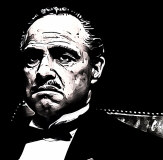 The mafia has been a source for inspiration and fascination for over a
century. It frequently appears in books and movies either as a driving source of
the story or a way to add flavor to it. It has become as much a part of the
American mythos as cowboys and Indians or Western Expansion. In stories, mafiosi
are as often heroes (or at least anti-heroes) as they are villains. They are
frequently romanticized, and their associated code of honor makes it easy to
view them in a positive light. The mafia has been a source for inspiration and fascination for over a
century. It frequently appears in books and movies either as a driving source of
the story or a way to add flavor to it. It has become as much a part of the
American mythos as cowboys and Indians or Western Expansion. In stories, mafiosi
are as often heroes (or at least anti-heroes) as they are villains. They are
frequently romanticized, and their associated code of honor makes it easy to
view them in a positive light.
1) The Original Meaning of Mafia
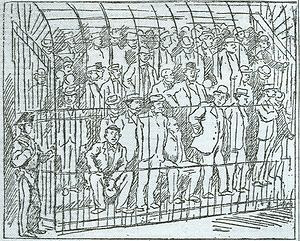 Popular culture references lead us to
believe that "mafia" means something like "family." While family plays a part in
what the organization is, though, it isn't a direct translation of the word. The
origin of the word "mafia" is just as shrouded in myth as the rest of the
organization. There are two popular theories about the possible origin. They
both date back to medieval Sicily. Popular culture references lead us to
believe that "mafia" means something like "family." While family plays a part in
what the organization is, though, it isn't a direct translation of the word. The
origin of the word "mafia" is just as shrouded in myth as the rest of the
organization. There are two popular theories about the possible origin. They
both date back to medieval Sicily.
The first theory is that the word comes from the 9th century when Sicily was
ruled by the Arabs. In this theory, the word "mafia" is derived from an Arabic
term referring to safety. It was used to refer to people who were seeking refuge
from foreign invaders. A related theory put forth by Selwyn Raab is that mafia
comes from a slang expression meaning "acting as a protector against the
arrogance of the powerful." Various Arabic terms that may have been the origin
of "mafia" are "marfud" (bravado), "mahyas" (boasting), "maha" (cave), and "mu'afa"
(protection).
The second theory about the origin of the name is that it comes from a saying
used during the French invasion of Sicily in 1282. The saying was "MorteAllaFrancia
Italia Anela" which translates to "Death to France, Italy Begs." The acronym of
this would have been "mafia." However, this seems like more fancy than truth.
Most historians disregard this theory in favor of the Arabic slang terms.
2) The Omertà
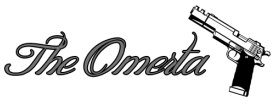 Omertà translates to "manhood" and refers to the idea that a man
should deal with his own problems. It became synonymous with the mafia's code of
silence in the 19th century. The Omertà is a strict code that forbids mafiosi
from betraying their fellows to authorities. The punishment for breaking the
Omertà is death. Discretion is valued as secrecy is necessary for many mafia
undertakings. Omertà translates to "manhood" and refers to the idea that a man
should deal with his own problems. It became synonymous with the mafia's code of
silence in the 19th century. The Omertà is a strict code that forbids mafiosi
from betraying their fellows to authorities. The punishment for breaking the
Omertà is death. Discretion is valued as secrecy is necessary for many mafia
undertakings.
The values of the Omertà can clearly be seen in how the mafia is generally
portrayed. Rather than brutish thugs, mafiosi are usually shown as practical
gentlemen. This can be seen in the clothing they wear in films and art - usually
suits or something that could pass for business casual attire. It is a look that
could pass unnoticed in most any situation. And it implies that while a mafioso
can get his hands dirty if needed, he's prefer to deal in a more civilized
fashion.
Certain crimes are considered forbidden under Omertà as they draw too much
attention to the mafia. Kidnapping is one of these. Theft is another. While
these rules are occasionally violated, the repercussions can be harsh. In some
families, the killing of prominent political figures is forbidden. This is for
the same reason – to avoid drawing attention and repercussions to the family.
Occasionally crimes such as adultery that can cause undo internal conflict are
also banned.
3) Protection Racketeering
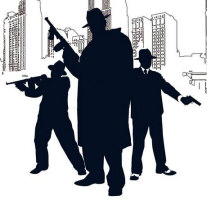 One of the classic crimes associated with the mafia
is protection racketeering. The basic concept is that a person (usually a
business owner) enters into an agreement with the local mafia to protect himself
against violence and thieves. The mafia makes it known that acts against the
protected individual will be punished. It is much like having a private security
firm without the niceties of the law limiting their available resources. One of the classic crimes associated with the mafia
is protection racketeering. The basic concept is that a person (usually a
business owner) enters into an agreement with the local mafia to protect himself
against violence and thieves. The mafia makes it known that acts against the
protected individual will be punished. It is much like having a private security
firm without the niceties of the law limiting their available resources.
Protection racketeering is often painted as a benevolent crime. Except in
cases of extortion, the only people getting hurt are those who seek to hurt in
the first place. Who's going to complain when a thief gets beaten up and the
property he stole is returned to its owner? More sinister aspects of protection
racketeering see honest competitors threatened or forced out of business.
Protection rackets find their origin in the early history of the mafia. In
the 1800s, groups formed to protect themselves against invaders and each other.
These private armies were referred to as "mafie." They extended this protection
to landowners in exchange for money. While extortion was part of this, it wasn't
always necessary. Some landowners were happy to pay for reliable protection
against foreign invaders.
4) Government Goons
|
Sicily, Italy:

|
The mafia actually had an important part in the
unification of Italy. Prior to 1815, the Italian peninsula was a collection of
different city-states. Between 1815 and 1870, these states slowly joined
together to form what we now know as Italy. Sicily became part of unified Italy
in 1861. Unification wasn't peaceful. Crime and chaos were rampant on the island
while the government sought to establish itself.
In a step that may have helped permanently entrench the mafia in the new
Italy, the government sought their help in the 1870s. Roman officials asked the
mafia clans to help them deal with dangerous criminal bands. In exchange, the
government would ignore the mafia's protection racket. In its own way, the
government was signing up for protection services as well. The mafia took
advantage of this supposedly temporary arrangement to establish its presence in
Sicilian politics. Mafia clans quickly mastered the art of political corruption.
Votes were often bought through bribery and intimidation. They remain a power to
this day, though their influence is waning somewhat. While they don't have
specific party affiliations, they do tend to avoid extreme ideologies such as
fascism.
5) The American Mafia and New Orleans
|
David C. Hennessy:

|
The American mafia is traced back to New
Orleans in the late 1800s. During this time, there was much emigration from
southern Italy to Brazil and Argentina. New Orleans was an active port for
travel to both locations. In 1869, the New Orleans Times ran an article
reporting on the activities of "notorious Sicilian murderers." This was the
first published report of mafia activity in the United States.
The first recorded incident was in 1890. The New Orleans Police
Superintendent David C. Hennessy was murdered execution-style. Hundreds of Sicilians were arrested
during the investigation. Nineteen were indicted for the murder and then
acquitted. There were rumors of bribery and witness intimidation. New Orleans
citizens formed a lynch mob which killed eleven of the defendants. This was the
largest mass lynching in United States history. It has never been determined if
the murder that started it all was actually the work of Sicilian immigrants. It
is suspected the murder may have been the work of nativists aiming to frame the
immigrants.
6) The American Mafia and New York City
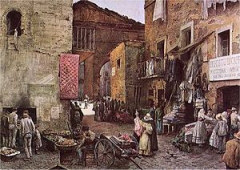 Concurrent with the events in New
Orleans, the American mafia was making its appearance in New York City. Mafia
groups initially formed in Italian ghettos. They grew gradually to citywide
organizations. Many of these were referred to as "the Black Hand" for their
extortion methods. The Black Hand was not a criminal organization itself, but
rather the method used. Concurrent with the events in New
Orleans, the American mafia was making its appearance in New York City. Mafia
groups initially formed in Italian ghettos. They grew gradually to citywide
organizations. Many of these were referred to as "the Black Hand" for their
extortion methods. The Black Hand was not a criminal organization itself, but
rather the method used.
The power of the mafia in New York City continued to grow through the early
1900s. The Sicilian mafia became the Five Points Gang and was active in the
Lower East Side. Other mafia families gained power in East Harlem and Brooklyn.
There was some spread to other cities, like Chicago. However, it wasn't until
Prohibition began in 1920 that the American mafia became a widespread national
phenomenon.
7) No Booze? No Problem.
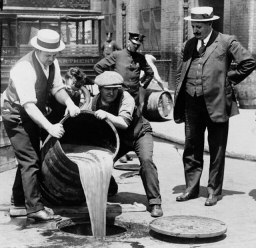 Prohibition began on January 17, 1920 with the
enactment of the Eighteenth Amendment. This made it illegal to manufacture,
transport, or sell alcohol. Enforcement was managed through the Volstead Act.
Prohibition was the end result of the Temperance movement, which had existed in
various forms since the 18th century. The idea behind it was that by making
alcohol illegal, the well-known social problems related to alcoholism would
vanish. This was, of course, not at all what happened. Prohibition began on January 17, 1920 with the
enactment of the Eighteenth Amendment. This made it illegal to manufacture,
transport, or sell alcohol. Enforcement was managed through the Volstead Act.
Prohibition was the end result of the Temperance movement, which had existed in
various forms since the 18th century. The idea behind it was that by making
alcohol illegal, the well-known social problems related to alcoholism would
vanish. This was, of course, not at all what happened.
Rather than give up alcohol cold turkey, those who liked to drink continued
to drink. And because of that, they were now criminals. Of course, that didn't
make much sense to the people involved. They weren't doing anything differently,
after all. Rather than make people avoid alcohol, Prohibition made people more
accepting of "harmless" criminal activity. It created an atmosphere of tolerance
in which the mafia flourished. Everyone knew someone with a homemade still or
where to go to get some bootleg booze. Corruption of law enforcement officials
was widespread and many turned a blind eye (usually for a fee) to illegal
smuggling activities.
Faced with the need for alcohol, the mafia began bootlegging. Liquor was
smuggled in from Canada and the Caribbean. Illegal stills were set up throughout
the country to manufacture alcohol. The profits that could be made during
Prohibition were enormous. Over 900,000 cases of liquor were smuggled into the
country. Mafia families quickly began competing for control over bootlegging
operations. Their efforts started as early as 1921. The resulting wars were
violent and helped embed the idea of the American mafia into the national
psyche. The struggle between Joe Masseria and Salvatore Maranzano for ultimate
control over the American mafia is well documented. The names of mafia dons from
this era stay with us to this day. Who hasn't heard of Al Capone or Lucky
Luciano? Even outside of history, they are frequently co-opted for stories and
legends.
8) The Boss of All Bosses
|
Maranzano:
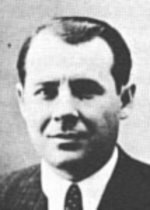
|
"Capo di tutticapi" in Italian, or the "boss of all
bosses," is the title given to supremely powerful mafia dons. In English, the
title "the Godfather" is widely used as well. While the title was used earlier,
it came into prominent use during Prohibition. Joe Masseria and Salvatore
Maranzano used the title during their efforts to take control of the many
different mafia families. Maranzano was murdered in 1931 and Lucky Luciano
created the Commission.
The Commission was an organization of the bosses of the Five Families in New
York. It also included representatives from other cities such as Chicago and
Kansas City. The men in The Commission were supposed to have equal say in mafia
matters. None of them were titled boss of all bosses by the Commission, though
media frequently used the term to identify the most powerful boss. Lucky Luciano,
Frank Costello, and Vito Genovese were some of the men referred to by this
title. Joseph Bonanno followed them, then the Gambino crime family. In recent
years, the term has fallen out of use. It is becoming more and more a thing of
the past and part of the romanticization of the mafia.
9) The Godfather
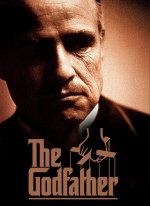 The film The Godfather is one of the best known gangster
movies. It is considered one of the greatest American movies ever made. The
Godfather has done much to ensure that the mafia remains part of the American
mythos. It is based on a novel written by Mario Puzo, which was in turn based on
pulp fiction novels and news articles about the mafia. The Godfather follows the
fictional Corleone crime family. The film The Godfather is one of the best known gangster
movies. It is considered one of the greatest American movies ever made. The
Godfather has done much to ensure that the mafia remains part of the American
mythos. It is based on a novel written by Mario Puzo, which was in turn based on
pulp fiction novels and news articles about the mafia. The Godfather follows the
fictional Corleone crime family.
The Corleone crime family was inspired by both the Borgias from Renaissance
Italy and the Bonanno crime family. The Bonanno crime family is one of the Five
Families that were part of the Commission. In the 1960s, Joseph Bonanno
attempted to seize leadership of the Commission. His failure resulted in turmoil
and infighting in the family. Ultimately, the Bonanno crime family was kicked
off the Commission because of this. The Bonanno family was much in the media
when Puzo was writing the Godfather.
10) Racketeer Influenced and Corrupt Organizations Act
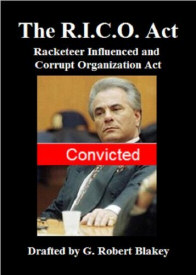 Traditionally, law
enforcement has had a terrible time convicting mafiosi. By the 20th century, the
mafia had nearly two hundred years of practiced organized secrecy to draw from.
(Nearly a thousand if we go back to the earliest origins of the concept.) The
values of discretion and the often gray nature of the crimes involved made
prosecution difficult. Witnesses were often bribed or intimidated into going
away. While it was clear to law enforcement that organized crime was a serious
problem, it took years for methods of investigation to change and become truly
effective. Traditionally, law
enforcement has had a terrible time convicting mafiosi. By the 20th century, the
mafia had nearly two hundred years of practiced organized secrecy to draw from.
(Nearly a thousand if we go back to the earliest origins of the concept.) The
values of discretion and the often gray nature of the crimes involved made
prosecution difficult. Witnesses were often bribed or intimidated into going
away. While it was clear to law enforcement that organized crime was a serious
problem, it took years for methods of investigation to change and become truly
effective.
In 1970, the Racketeer Influenced and Corrupt Organizations (RICO) Act became
federal law. The RICO act allowed leaders of organized crime to be prosecuted
for the actions of their underlings. Violation of the RICO Act is punishable by
up to 20 years in prison. Since its enactment, the RICO Act has proven extremely
useful. For example, between 1981 and 1992, 23 bosses, 13 underbosses, and 43
captains have been convicted under the RICO Act. Prior to the RICO Act, mafia
bosses generally had to be tried for far less serious crimes.
11) Al Capone and Tax Evasion
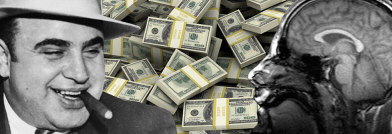 Al Capone was a famous Chicago mafia boss. He
was born in New York City in 1899. He joined the Five Points Gang. In 1923, he
moved to Chicago where he was recruited by Johnny Torrio to take advantage of
the opportunities provided by Prohibition. Capone grew in power in Chicago
throughout the Prohibition era. He controlled large portions of the Chicago vice
industries such as gambling and prostitution, as well as bootlegging. An
estimated $100 million per year was earned. He had also thoroughly corrupted the
local government. He rigged at least one mayoral election and controlled
officials through bribery and blackmail. Al Capone was a famous Chicago mafia boss. He
was born in New York City in 1899. He joined the Five Points Gang. In 1923, he
moved to Chicago where he was recruited by Johnny Torrio to take advantage of
the opportunities provided by Prohibition. Capone grew in power in Chicago
throughout the Prohibition era. He controlled large portions of the Chicago vice
industries such as gambling and prostitution, as well as bootlegging. An
estimated $100 million per year was earned. He had also thoroughly corrupted the
local government. He rigged at least one mayoral election and controlled
officials through bribery and blackmail.
The Bureau of Prohibition's investigation into Capone started in 1929. Agent
Eliot Ness was attempting to find ways to convict Capone on Volstead Act
violations. (The Volstead Act was the vehicle through which Prohibition was
enforced.) However, the evidence was weak. Concurrent to this, Frank J. Wilson
began an investigation of Capone for income tax evasion. Capone was indicted for
income tax evasion and violations of the Volstead Act in 1931. The trial was
long, and the Volstead Act violation charges were ultimately dropped. At the end
of it, Capone was sentenced to 11 years imprisonment for the income tax evasion
charges. At the time, this was the longest tax evasion sentence ever given.
Heavy fines were also issued. He was transferred to Alcatraz in 1934, and
eventually paroled in 1939.
12) Lucky Luciano
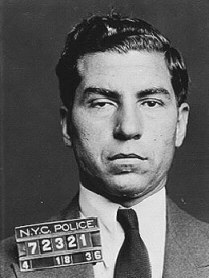 Charles Luciano was born Salvatore Lucania in LercaraFriddi,
Sicily. He was born in 1897. His family immigrated to the United States in 1907
and settled in New York. Luciano dropped out of school at 14 and took a job
delivering hats. However, he quickly turned to less respectable work. After
winning $244 in a dice game, he quit his job. Shortly thereafter, he started his
own gang. His first efforts were a protection racket for Jewish youth. Charles Luciano was born Salvatore Lucania in LercaraFriddi,
Sicily. He was born in 1897. His family immigrated to the United States in 1907
and settled in New York. Luciano dropped out of school at 14 and took a job
delivering hats. However, he quickly turned to less respectable work. After
winning $244 in a dice game, he quit his job. Shortly thereafter, he started his
own gang. His first efforts were a protection racket for Jewish youth.
There are several theories as to how Luciano gained the nickname "Lucky." It
may be a mispronunciation of his surname. It could also be a reference to one of
several fortunate outcomes in his criminal career. Between 1916 and 1936,
Luciana was arrested 25 times. The charges ranged from assault to blackmail and
illegal gambling. He spent no time in prison. In 1920, he was severely beaten by
three men because he refused to work for another mafia boss. His throat was also
slashed. He survived.
Luciano became a powerful figure in the Masseiria organization during
Prohibition. Masseira was the primary rival to Salvatore Maranzano during what
came to be called the Castellammarese War. This battle for dominance over the
nation's organized crime ended with Maranzano in charge and Masseira dead. After
a lovely hash of betrayals and deaths, Maranzano's organization was broken.
Luciano organized the Commission and became the unofficial leader of the
organization.
In 1936, Luciano was arrested for compulsory prostitution. He was tried as
part of a massive prostitution ring. He was convicted of 62 counts of compulsory
prostitution and sentenced to 50 years in state prison. There is considerable
doubt as to the veracity of his involvement in prostitution, but appeals to the
case were unsuccessful. He was finally freed after assisting in the U.S. war
effort in Sicily during World War II. In 1946 he was deported to Italy.
13) Federal Witness Protection
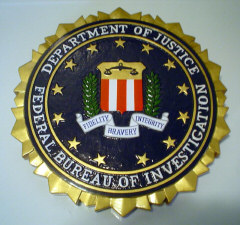 The Federal Witness Protection Program (WITSEC)
was established in 1970. It is part of the Organized Crime Control Act. It
allows the federal government to provide protection and relocation services for
witnesses and potential witnesses in cases involved organized crime or other
serious offenses. WITSEC was important to enabling prosecution of mafia bosses.
Without it witnesses could not be certain they would survive testifying.
Combined with promises of immunity from prosecution, WITSEC has led many mafia
members to break their code of silence. The Federal Witness Protection Program (WITSEC)
was established in 1970. It is part of the Organized Crime Control Act. It
allows the federal government to provide protection and relocation services for
witnesses and potential witnesses in cases involved organized crime or other
serious offenses. WITSEC was important to enabling prosecution of mafia bosses.
Without it witnesses could not be certain they would survive testifying.
Combined with promises of immunity from prosecution, WITSEC has led many mafia
members to break their code of silence.
During the 1990s, dozens of mobsters testified and provided information which
led to the conviction and imprisonment of hundreds more. Since then, the mafia
has been in decline. Other criminal organizations have moved in to fill some of
the vacuum. The mafia remains the dominate force in United States organized
crime, but there has been an overall decline. This is in part due to the
reassurance WITSEC provides for those who do testify against the mafia.
The first breach in WITSEC security happened in 2009. This was nearly 40
years after it was initially established. U.S. marshal John T. Ambrose leaked
information to the Chicago mob about a former hitman who was in WITSEC. Ambrose
received a four year prison sentence for his crime.
14) Hodge-Podge Initiation Rituals
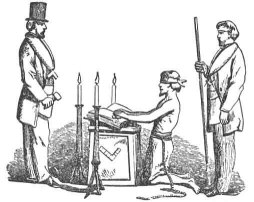 To become a full member of the mafia, an
aspirant has to pass an initiation ritual. These rituals differ from family to
family, but have some things in common. They all involve significant rituals,
oaths, blood, and an agreement to follow the rules of the mafia. This ritual can
be dated back to 1877 in Sicily, though it probably is older than that. To become a full member of the mafia, an
aspirant has to pass an initiation ritual. These rituals differ from family to
family, but have some things in common. They all involve significant rituals,
oaths, blood, and an agreement to follow the rules of the mafia. This ritual can
be dated back to 1877 in Sicily, though it probably is older than that.
The ritual aspect of the ceremony takes inspiration from Masonic rituals and
the Catholic Church. The second probably can be dated to the Sicilian mafia's
involvement in protecting Church interests immediately following the unification
of Italy. Part of the ritual is being baptized again. Oaths of family and
brotherhood are sworn. A finger is pricked (supposedly the trigger finger) to
symbolize being part of the family. Some versions of the ceremony involve
burning a picture of a saint. The initiation is done after the aspirant has
completed any other requirements to become a made man. This is generally a
contract killing, though prior to the 1980s the individual's involvement could
be periphery. Other requirements to become a made man include ethnicity, though
this has been somewhat relaxed. Rather than full Italian descent, many families
now allow those with Italian heritage on only one side to become made men.
15) Salvatore Maranzano and the Castellammarese War
|
Joe Masseria:
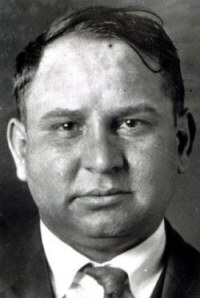
|
Salvatore Maranzano was
born in 1886 in Castellammare del Golfo, Sicily. He became involved with the
Sicilian mafia after studying to become a priest. He was one of the early mafia
bosses in the United States. He immigrated to the United States as an adult
shortly after the start of World War I and settled in Brooklyn. There he built
both a legitimate real estate business and a bootlegging operation. He expanded
his criminal activities to include prostitution and smuggling. The success of
his organization was greatly aided by the advent of Prohibition.
In 1930, Maranzano declared war on his chief rival, Joe Masseria. At the
time, Masseria was considered the boss of all bosses. The war was called the
Castellammarese War after Maranzano's place of birth. The precise cause for the
start of the war is hard to pinpoint, however tensions had been building
throughout the Prohibition era. Both sides frequently hijacked each other's
alcohol and there was marked tension between the old guard (which included
Maranzano) and the younger generation. Loyalties shifted rapidly between sides
as different points of tension shifted.
Most sources consider the opening of the war to be at the hands of Masseria's
faction. Masseria ordered the murder of Gaetano Reina in 1930 with the intent of
protecting several of his secret allies. The Reina family reacted by putting
their support behind Maranzano. The war rapidly shifted in favor of Maranzano.
On April 15, 1931 Masseiria was killed and Maranzano declared himself the new
boss of all bosses. This was short lived. Just six months later, he was killed
in his Manhattan office.
Conclusion
The mafia has made a lasting impact on the American landscape. This can be
seen in movies such as The Godfather, Scarface, and the Untouchables. There are
dozens of films, television shows, and notable books that draw inspiration from
rituals, organization, and actions of mafia families and members. Even when they
aren't in the starring roles, mafia members and associates often play supporting
roles in detective novels and period fiction. The mix of ruthlessness and honor
is an alluring combination for anyone trying to give a character life. It's no
wonder they are such a fixture in American culture.
Legal
Top 20 Most Ridiculous Lawsuits
25 Funny & Crazy Arrest Stories
10 Innocent People who Died on Death Row
Top 15 Myths About Guns
15 Cool Things Prisoners Get To Have In Jail
Top 15 Illegal Drugs That Used To Be Legal
15 Unusual Ways Crimes Have Been Solved
15 Survivor Accounts of Gruesome Crimes
Top 20 Most Ignored Road Signs & Their Accidents
15 Fascinating Facts about the Mafia
15 Weird Actions That Are Prosecuted in the Modern World
15 Legal Counsel That Have Never Lost Court Cases
The Adverse Effects of Intellectual Property Laws on the World of Art |